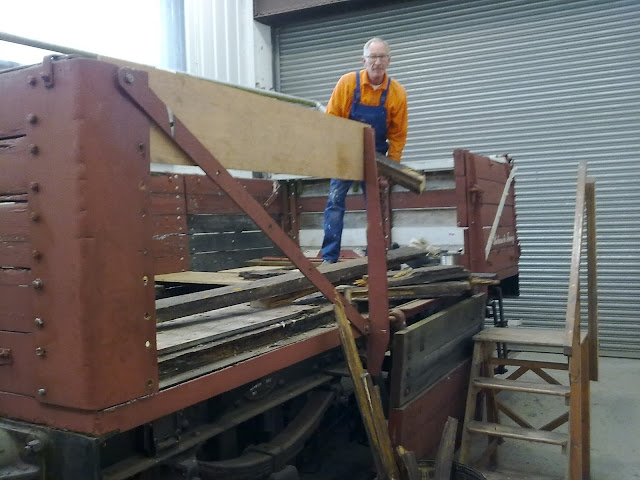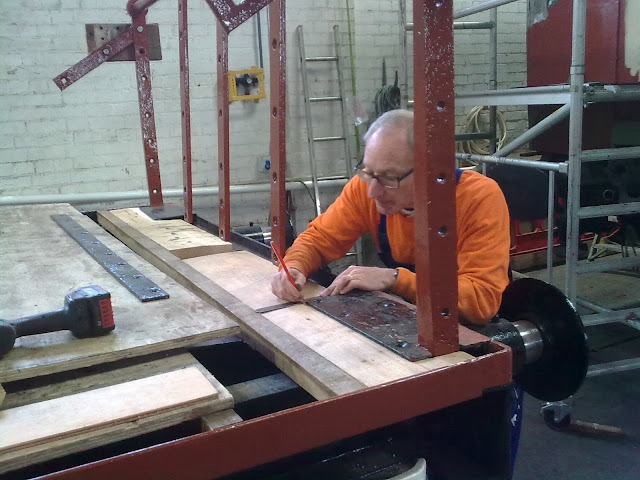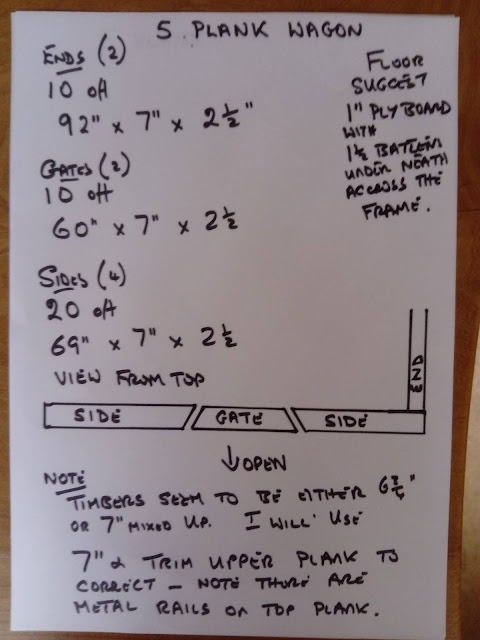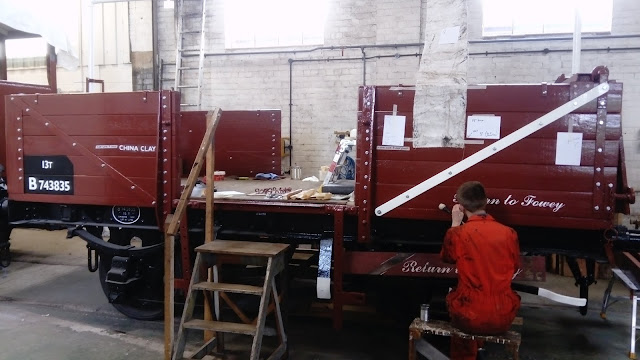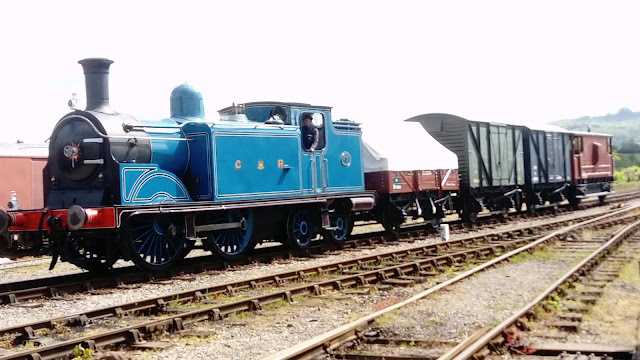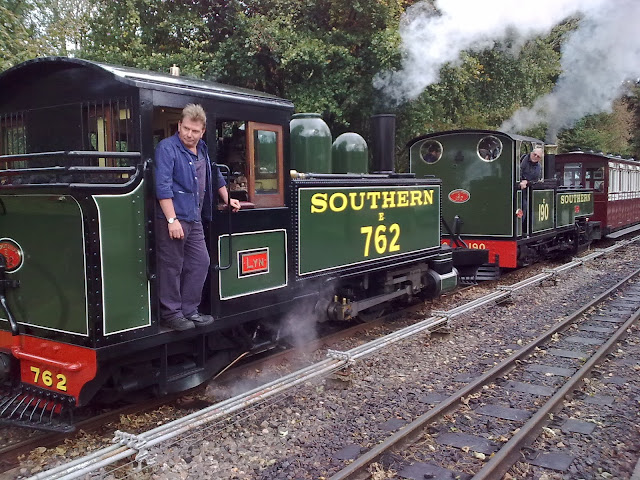I have been going to Exmoor for almost 40 years and this part of the UK, and Lynton and Lynmouth in particular, remains my favourite.
Things there have changed quite a bit since that August Bank Holiday back in 1983 when I first enjoyed the delights of Lynmouth, the East Lyn Valley and the surrounding moorland scenery.
The Cliff Railway between Lynmouth and Lynton had been running since 1890, but not that intruder which appeared in 1898 and sadly lasted no more that 37 years, closing in 1935.
The old Southern Railway station sign at the Museum in Lynton.
However a small part of that sadly missed little railway slowly reappeared and, since reopening in 2004, now plays a major part of the tourism of Exmoor and North Devon. It is strongly supported by both Exmoor National Park and North Devon Council.
Its current running line might be just 1 mile in length, but by autumn 2017 the railway had carried 500,000 passengers. More and more trackbed along the route of the old line is gradually being acquired by sister organisation Exmoor Enterprises, new bridges have been put in south of Blackmoor Gate, the old stations at Woody Bay, Bratton Fleming (only recently acquired) and Chelfham are owned by the railway, and the spectacular Chelfham Viaduct is just waiting for track to be relaid.
The L&B Trust submitted seven planning applications to extend the
railway to Blackmoor Gate and Wistlandpound Reservoir. These have now
all been approved by both Exmoor National Park
and North Devon Council. Having achieved this objective, a Transport and
Works Act Order is now being sought to provide the powers to rebuild and operate
the railway.
Most amazing has been the recreation of "Lyn", one of the original locos built by Baldwin, and five rebuilt carriages, making it all something really special. The restorations of an original goods van and a sixth carriage are underway, as is the project to recreate two more of the original Manning Wardles "Yeo" and "Exe". Add to that the replica Manning Wardle loco "Lyd" visiting from the Ffestiniog and it's easy to see why the December 2019 issue of Steam Railway had as its No. 1 milestone moment, a photo of the two locos and their trains at Woody Bay. In the associated write-up it stated, "Today's L&B at Woody Bay is perhaps the finest showcase for what preservation can achieve". Having been a member since the opening day in 2004 and visited the little railway a number of times now, I would certainly go along with that.
In normal (non-pandemic) times there are two annual galas at Woody Bay. The May Gala is primarily based around the annual AGMs for the Community Interest Company and the Trust, and is the quieter one of the two. The main Gala is in the autumn and held at the end of September, and as such timing it to coincide with the date when the original railway was closed. With "Lyd" visiting from the Ffestiniog, and the chance to see both "Lyn" and "Lyd" working together, the difference in attendance is something else.
The following sequence is mainly from the September 2018 Gala, with some additional photos from the May 2018 and May 2019 Galas.
***********************************************************************************************************
September 2018 Gala
Recreating the famous double-header and what every gala visitor wants to see. The Autumn Gala in 2019 would see this train with five coaches.
The locos are facing exactly as they did when the original line was running. There were no turntables on the line.
On the double header returning to Woody Bay.
Yes, that climb to Woody Bay is steep! The gradient is quite dramatic when looking at the line snaking its way uphill from Killington Lane.
The lovingly recreated Manning Wardle given the next number in the series and the new name "Lyd". All the L&B locos were named after rivers with 3-letter names. For the 2019 Autumn Gala, which unfortunately we were unable to attend, "Lyd" was temporarily renamed "Lew" and renumbered "E188".
This is "Faith", tiny in comparison with the rest, but still a powerful little engine. She was built by John Uphill, the L&B's resident engineer. and is normally based at the Gartell Light Railway near Templecombe.
Faith
took 17 years to build and when I first saw her she was for sale, but
did this happen? She was in steam at the May 2019 Gala and the "For
sale" notice had gone.
At the other end of the goods train was "Axe". She is Kerr, Stuart & Co Ltd No. 2451, built at Stoke-on-Trent in 1915. A
side and well tank locomotive, she was one of seventy 60cm gauge
"Joffre" Class (named after the French First World War Commander)
ordered by the French government for service on the Western Front.
After a long mixed history, by the end of WWII she out of use. Then in 1974, along with four others of the same class, she was repatriated to the UK. After a period of storage in North Wales she was
eventually bought by the L&B in 1983 and named "Axe" in keeping with
the 3-letter river theme. Restoration was started by the railway before
she was sent to the Gartell Railway for completion. She began working
L&B trains in March 2009.

Returning to "Lyd", she first ran on the L&B at the Autumn Gala in September 2010. She had been built at the Ffestiniog over a period of 15 years and first steamed in May 2010. She is based on "Lew", the last Manning Wardle to be built for the L&B (by then taken over by the Southern Railway) in 1925. Lew was a slightly modified version of the original three locos, Exe, Taw and Yeo. She was involved with the dismantling of the L&B in 1936, after which she was purchased and shipped to Brazil and an unknown future, and eventually into history as the "Lew Enigma". There are many who hope she is still out there somewhere, albeit a rusting hulk.
Inside "Lyd"'s cab
The project to build a new "Lyn" began in 2009. Over the successive years parts were created and the final assembly completed at Alan Keefe Ltd, Ross-on-Wye. She first steamed in July 2017 and in the following September Gala made her debut. She is the gem of the L&B and hopefully in the not too distant future will be joined by the new "Exe" and "Yeo". Apparently when she visited the Ffestiniog they were so impressed with her that they jokingly asked if they could keep her and return "Lyd" instead! As with "Lyd", "Lyn" has been built to modern standards and efficiency, and will be a lot better than the original Baldwin engine, which was thought by L&B crews to be not as strong as the Manning Wardles - she was often double-headed, hence the much requested recreation at the autumn galas.

All the galas have lots of extra attractions, in particular a delightful range of miniature traction engines. There is also a miniature railway that gives rides, a selection of period road vehicles and a marquee with model narrow gauge railways (from the L&B to industrial), various displays, and things for sale.
This was our first visit to an Autumn Gala, and at the moment, the only one so far. We came away very impressed with the whole day.
**************************************************
Returning to the Railway two days later had a lovely surprise in store.
Initially the day presented a very atmospheric scene with a mist blanketing everything.
As this was the first train of the day very few visitors were around, and it was as though it had all been set up just for us.
Being so quiet certainly had its bonuses and we were able to view "Lyn" far more closely.
Now who's that about to drive Lyn away? Hey, wait for me !!

On the first run down to Killington Lane.
About to begin the return to Woody Bay. The line snakes away up the 1:50 gradient.Approaching Woody Bay
The very pleasant surprise was seeing "Lyd" shunted out of the shed. She wasn't in steam, but was presumably being prepared for the return to Boston Lodge.
Leaving to return to our hotel in Lynton with a last look back at "Lyd". **********************************************************************************************************
May 2018 Gala
A selection from the previous gala

This turned out to be a glorious Spring day, enhancing the equally glorious view from Woody Bay Station, which is the highest point on the old railway. In the distance the Hangman peaks with the Bristol Channel to their right, and on a clear day, the coast of Wales.
Lyn slows as she approaches the station.
The carriages have been beautifully restored
That glorious view from the train.
On the 1:50 climb from Killington Lane, the current limit of the line.

One of the beautifully restored First Class compartments ............... and the view from it
"Tazmin", one of the delightful miniature locos
The miniature woodland line that runs along the top of the Woody Bay site. It extends a lot farther than you first think.
**********************************************************************************************************
May 2019 Gala
A few photos from this much quieter gala, but again a lovely day. As with all the spring galas, it was just "Lyn" as the main loco. "Lyd" comes down to Devon for the autumn galas only.
Some more miniature traction engines were on display.
It was best behaviour in the afternoon when Her Royal Highness visited and enjoyed a ride on the line. The speed was kept down too as it was known that she did not like high speed rail travel.
At times it was hard to believe this was a gala with spells of delicious peace and calm, even though there were plenty of visitors, but this was the lunch spell and everyone was elsewhere. At times like this Woody Bay Station is a lovely setting where you can relax and forget the rest of the world. Even the nearby A39 was quiet.
**********************************************************************************************************
And finally ....
Despite the pandemic, the little railway continues to go from strength to strength, with all its long term plans either in motion or at least in preparation. As with all restorations of this magnitude, it will be very many years before Lynton is once more linked up to Barnstaple by railway, but its popularity and determination will certainly mean that it will have a jolly good try.
To see everything in action the Railway's website (https://www.lynton-rail.co.uk/) has a good lengthy introductory video with scenes both from Galas and normal running, many including that fantastic view.
There are also many videos on YouTube, including pre-1935 historical ones.
**********************************************************************************************************
Having
been a volunteer at GWSR C&W for 13 years and over that time very much
involved in its running, dare I whisper it gently that my very favourite
railway is actually the Lynton & Barnstaple?
As Jeremy Clarkson used to say at the end of every Top Gear programme:
"And on that bombshell ..........."




